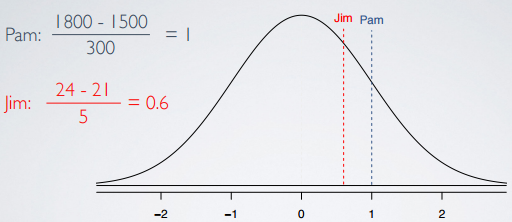Standardized score - Z score
Definition of Standardized (Z) score
The standardized (Z) score of an observation is the number of standard deviations it falls above or below the mean.
observation - mean
Z = -------------------
SD
Note: the Z actually comes from the Z in standardized, which might sound a little odd. The reason not using S, the initial letter of the word, is because we tend to spare S for standard deviations and we don't want to be confusing our abbreviations.
Z score features
Here are some features about Z score:
- Z score of mean is zero;
- Usually, observation with |Z| > 2 are considered as unusual.
Standardizing with Z scores
Use 68-95-99.7% rule to estimate the standard deviationA college admissions officer wants to determine which of the two applicants scored better on their standardized test with respect to the other test takers: Pam, who earned an 1800 on her SAT, or Jim, who scored a 24 on his ACT?
- SAT score is nearly normally distributed with - N(mean=1500, SD=300)
- ACT score is nearly normally distributed with - N(mean=21, SD=5)
We can draw both Pam's and Jim's score:

We found we can't just compare these raw scores of 1800 vs. 24 since they are measured on different scales. Instead, we want to figure out how many standard deviations above the respected means of their distributions, they scored respectively.
1800 - 1500
Pam = ------------ = 1
300
24 - 21
Jim = -------- = 0.6
5

So, by ploting these values on the same distribution, we can see that Pam indeed do better than Jim.
These values are called standardized scores.
References & Resources
- N/A
Latest Post
- Dependency injection
- Directives and Pipes
- Data binding
- HTTP Get vs. Post
- Node.js is everywhere
- MongoDB root user
- Combine JavaScript and CSS
- Inline Small JavaScript and CSS
- Minify JavaScript and CSS
- Defer Parsing of JavaScript
- Prefer Async Script Loading
- Components, Bootstrap and DOM
- What is HEAD in git?
- Show the changes in Git.
- What is AngularJS 2?
- Confidence Interval for a Population Mean
- Accuracy vs. Precision
- Sampling Distribution
- Working with the Normal Distribution
- Standardized score - Z score
- Percentile
- Evaluating the Normal Distribution
- What is Nodejs? Advantages and disadvantage?
- How do I debug Nodejs applications?
- Sync directory search using fs.readdirSync